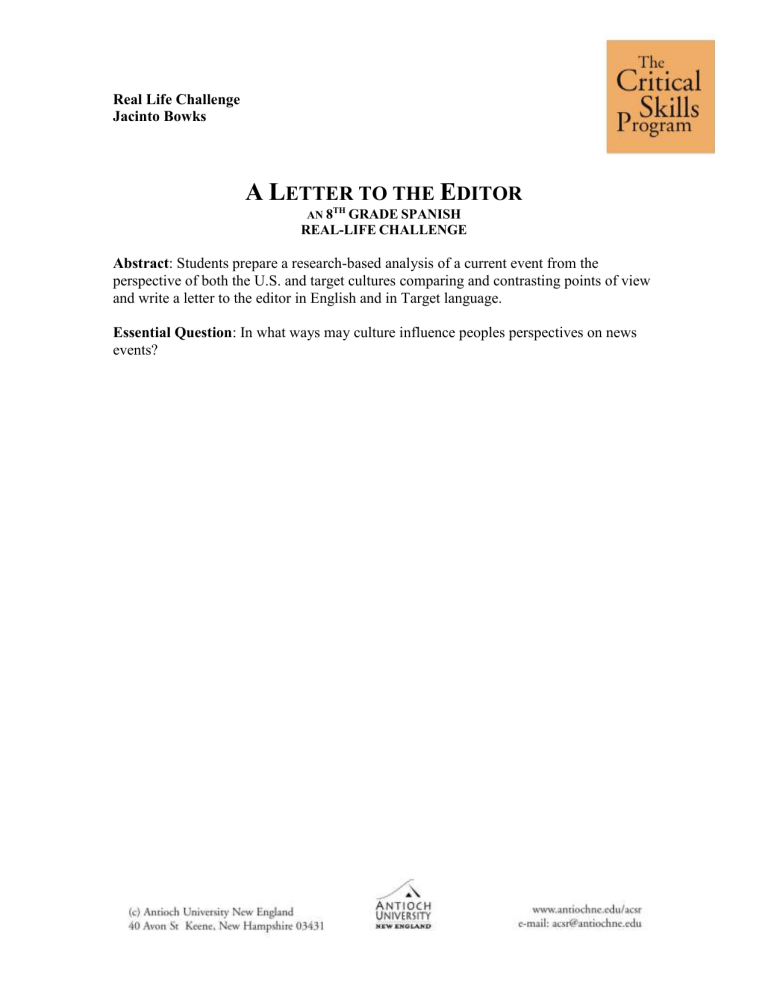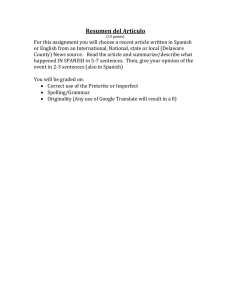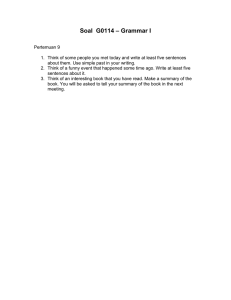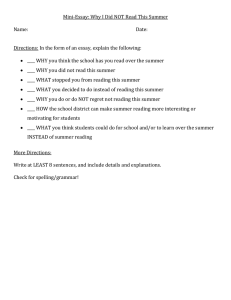A Letter to the Editor

Real Life Challenge
Jacinto Bowks
A L
ETTER TO THE
E
DITOR
AN 8 TH GRADE SPANISH
REAL-LIFE CHALLENGE
Abstract : Students prepare a research-based analysis of a current event from the perspective of both the U.S. and target cultures comparing and contrasting points of view and write a letter to the editor in English and in Target language.
Essential Question : In what ways may culture influence peoples perspectives on news events?
Dear 8 th
Grade Spanish Students:
It’s time to let your Spanish voice reach far and wide. You will be drafting and composing a Letter to the Editor of a major Mexican newspaper, Carmen Lira Saade who is the editor in charge of the Spanish language daily La Jornada . http://www.jornada.unam.mx/
It is hoped that you will have an opportunity to examine the ways culture may influence people’s perspectives on news events by means of our new challenge, in which you will prepare a research-based analysis of a current event from the perspective of both a
U.S. and a target culture newspaper comparing and contrasting points of view and writing a bilingual letter to the editor (in English and in the target language, Spanish). And so, for this assignment, you will need to build up your basic knowledge of everyday words in
Spanish. Words about current events such as you would find in newspaper articles. Also, you will have a chance to practice critical skills like problem solving, collaboration, leadership, communication, and time management. Working in small groups with a
“miximum” (maximum mix) of 3 to 5 students per group, you will research, translate, and discuss current event articles found in our resource links to online newspapers, then choose an article to that interests your group which is also written about in local newspapers. You will draft up, (making corrections as necessary), and compose a letter to the editor of La Jornada newspaper, which meets the criteria found in the rubrics for this challenge.
You must receive a check or check plus in order to meet the challenge and receive instructions on how to send the letter. Receipt of a check minus or “ x
” will mean your team needs to make corrections and/or improvements until your letter can meet the higher quality criteria in the check or check plus columns of the rubric.
Due to our emphasis in addressing the National Standards for Foreign Language
Learning with every class project, this time we will concentrate on the following
Standards : 1.1 Students work cooperatively in groups to improve knowledge of the target language. 4.1
Students compare and contrast language styles from media sources.
4.2
Students brainstorm cultural commonalities and dis-similarities in media sources. 5.2
Students develop insights necessary for achieving literacy in the target language.
Please submit a sheet of paper entitled “Group Log” at the end of this class with the following information: Name of the team members, with chosen assigned roles for
Group’s Facilitator/Leader, Recorder/Typist, Time-keeper/Logger. Everyone else in group will serve as a Researcher/Translator. The log must be turned in at the end of every class. You have three class periods to complete this challenge, plan accordingly and aim for excellence!
Letter to the Editor Rubric :
CATEGORY
Ideas
+
Ideas are expressed in a clear and organized fashion. It was easy to figure out what the letter was about.
Ideas are expressed in a pretty clear manner, but the organization could be improved.
Ideas are somewhat organized, but were not very clear. It took more than one reading to figure out what the letter was about.
The letter seemed to be a collection of unrelated sentences. It was very difficult to figure out what the letter was about.
Content Accuracy The letter contains 3 or more accurate facts gained from the research about the topic.
The letter contains at least 2 accurate facts
The letter contains only 1 accurate fact gained from the research about the topic. gained from the research about the topic.
The letter contains no accurate facts about the topic or distorts the historical facts.
Semantic format:
Length, Sentences
& Paragraphs
Grammar & spelling
(conventions)
The letter is four or more paragraphs long.
Paragraphs contain detail, topic sentences, and transitions.
Sentences are complete, wellconstructed and vary in structure.
The letter consists of two or three full paragraphs.
Paragraphs contain detail, topic sentences, and transitions. All sentences are complete and wellconstructed (no fragments, no runons).
The letter consists of only one paragraph.
But paragraph lacks detail, topic sentences, or transitions. Yet most sentences are grammatically correct and complete.
The letter does not contain even one full paragraph. Many incomplete sentence or run-on sentences OR paragraphing is inconsistent, incomplete, or confused.
Writer makes no errors in grammar or spelling.
Writer makes virtually no errors in grammar and/or spelling.
Writer makes a few errors in grammar and/or spelling
Writer makes several errors in grammar and/or spelling.
Salutation and
Closing
Salutation and closing have no errors.
Salutation and closing have virtually no errors.
Salutation and closing have a few errors.
Salutation and/or closing are missing.
Neatness
Translation into
Spanish
Letter is clean, neat, and very easy to read. It was done with great attention to detail.
There are no errors evident in word translation and letter is easy to understand in Spanish.
Letter is neat and clean, and is fairly easy to read. It was done with attention to detail.
There are virtually no errors in word translation, and these don’t detract from comprehension.
Letter is neat , but has 1-2 distracting error corrections, and reveals lack of
Letter is carelessly written. It may have several distracting error corrections. It looks careful proofreading. like it was done in a hurry with no proofreading.
There appear to be numerous errors in word translation making understanding the letter difficult.
The number of errors in translated word meanings, make letter virtually unreadable.
Are you ready to submit your letter to the editor? Make sure you have reviewed the rubrics before giving your letter to Sr. Bowks and accompany it with your daily “Group
Log” entries.


